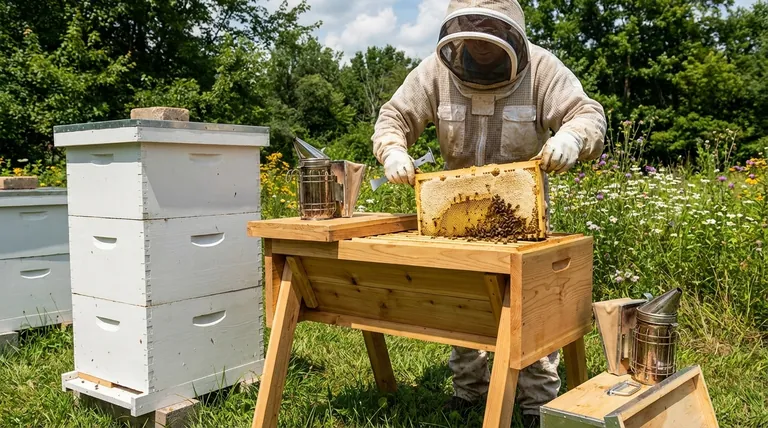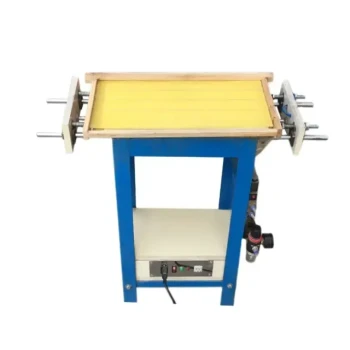At its core, a top-bar hive is a single, horizontal box where bees build their own comb naturally from simple bars, while a conventional framed hive is a modular, vertical system of boxes (supers) that use pre-made frames to guide comb construction. This fundamental difference in design dictates everything from the physical effort required to the philosophy of beekeeping each system supports.
The central distinction is one of philosophy and function. Top-bar hives prioritize simplicity and a less intrusive, more natural approach to beekeeping, whereas conventional Langstroth hives are standardized for scalability and maximizing honey production.

Core Design: Horizontal vs. Vertical Expansion
The most immediate difference is the shape and how the colony grows. This architectural distinction influences the entire beekeeping experience.
The Horizontal Top-Bar Hive
A top-bar hive is a single, long trough, often more than twice as wide as a conventional hive. The colony expands horizontally from the center outwards, filling the length of the box as the season progresses.
The Vertical Langstroth Hive
A conventional Langstroth hive is a stack of boxes. The colony expands vertically; as they fill one box with brood and resources, the beekeeper adds another box (a "super") on top.
Managing Colony Space
In a top-bar hive, you manage space using follower boards, which are solid dividers that can be moved to expand or contract the area the bees can access. In a Langstroth system, you manage space by adding or removing entire boxes.
The Nature of the Comb
How the bees build and store their resources is fundamentally different, impacting both the bees and the harvesting process.
Natural, Frameless Comb
Top-bar hives use simple wooden bars laid across the top of the hive. Bees build their comb downwards from these bars, creating natural, free-form structures without the guidance of a full frame or foundation.
Structured, Framed Comb
Langstroth hives use four-sided frames that typically hold a sheet of wax or plastic foundation, often imprinted with a hexagonal pattern. This foundation encourages bees to build straight, uniform, and durable combs that are easy to handle and inspect.
Management and Physical Effort
Your day-to-day interaction with the hive is heavily influenced by its design.
Inspection Intrusiveness
Inspecting a top-bar hive is a less disruptive process. You lift only one comb at a time, exposing just a small portion of the nest. Inspecting a Langstroth hive often requires taking off entire boxes to access the lower brood chamber, disturbing a much larger portion of the colony.
The Burden of Heavy Lifting
This is a critical distinction. Top-bar hive management involves no heavy lifting, as you only ever handle a single comb. Langstroth beekeeping requires lifting boxes full of honey, which can easily weigh over 50 pounds (23 kg).
Honey Harvesting: Simplicity vs. Efficiency
The way you collect honey is a direct result of the hive's comb design.
Crush and Strain Harvesting
With top-bar hives, honey is typically harvested by cutting the comb from the bar, crushing it, and straining the honey from the wax. This method requires minimal specialized equipment but destroys the honeycomb in the process.
Centrifugal Extraction
Langstroth frames are designed for extraction. The beekeeper uses a hot knife to slice off the wax cappings, then places the frames in a centrifugal extractor that spins the honey out. This method preserves the drawn-out comb, which can be returned to the hive, saving the bees immense energy.
Understanding the Trade-offs
Neither system is inherently superior; they are optimized for different goals and present unique challenges.
Cost and Accessibility
Top-bar hives have a lower initial cost and can be constructed from basic plans and scrap wood. Langstroth hives and the required extractor represent a more significant financial investment.
Honey Yield vs. Bee Energy
Langstroth hives are generally geared for higher honey production because returning empty, drawn comb to the bees allows them to focus solely on nectar collection. The "crush and strain" method requires the colony to rebuild new comb from scratch every time.
Comb Fragility
The natural comb in a top-bar hive is only attached at the top, making it more fragile than the fully supported comb in a Langstroth frame. Careless handling, especially in hot weather, can cause a top-bar comb to break off.
Making the Right Choice for Your Goals
Your beekeeping philosophy and physical capabilities should guide your decision.
- If your primary focus is natural beekeeping with minimal heavy lifting: A top-bar hive is the clear choice for its low-intervention style and ergonomic advantages.
- If your primary focus is maximizing honey production and using standard equipment: A Langstroth hive is the industry standard for its efficiency and scalability.
- If your primary focus is low initial cost and self-sufficiency: A top-bar hive can be built easily and does not require an expensive honey extractor.
- If your primary focus is interchanging parts or selling nucleus colonies: The standardization of the Langstroth system makes it far more practical.
Ultimately, choosing a hive is about selecting the tool that best aligns with your personal beekeeping objectives.
Summary Table:
| Feature | Top-Bar Hive | Langstroth Hive |
|---|---|---|
| Expansion | Horizontal | Vertical |
| Comb Type | Natural, frameless | Structured, with foundation |
| Physical Effort | No heavy lifting | Heavy boxes to lift |
| Harvesting Method | Crush and strain | Centrifugal extraction |
| Ideal For | Natural beekeeping, low cost | High honey yield, scalability |
Ready to equip your apiary with the right hive system?
Whether you manage a commercial operation or are a distributor stocking up, HONESTBEE provides the high-quality beekeeping supplies and equipment you need to succeed. From durable hive components to essential tools, our wholesale-focused operations ensure you get reliable gear for any beekeeping method.
Contact HONESTBEE today to discuss your specific needs and let us help you build a more productive and efficient apiary.
Visual Guide

Related Products
- HONESTBEE Advanced Ergonomic Stainless Steel Hive Tool for Beekeeping
- Professional Dual-End Stainless Steel Hive Tool for Beekeeping
- Professional 3-Bar Frame Grip with Integrated Hive Tool
- Plastic Bee Hive Stand for Beekeeping
- Professional Pneumatic Wire Embedder for Beehive Frames
People Also Ask
- What is a hive tool and what are its uses? Master Your Hive Inspections with the Essential Beekeeper's Tool
- What are some common uses of a hive tool? Essential Multi-Purpose Tool for Every Beekeeper
- What are the basic tools for beekeeping? Essential Starter Kit for Safe & Successful Hive Management
- Why is it important to compare the progress of different hives? A Beekeeper's Key Diagnostic Tool
- Why do hive tools have a hole? Unlock the Secret to Efficient Beekeeping



















